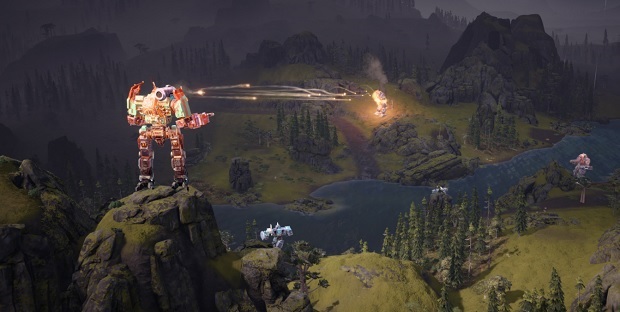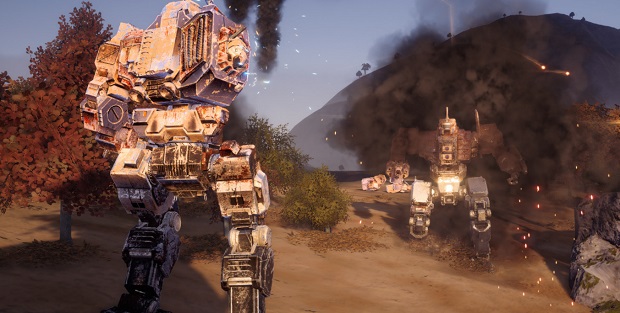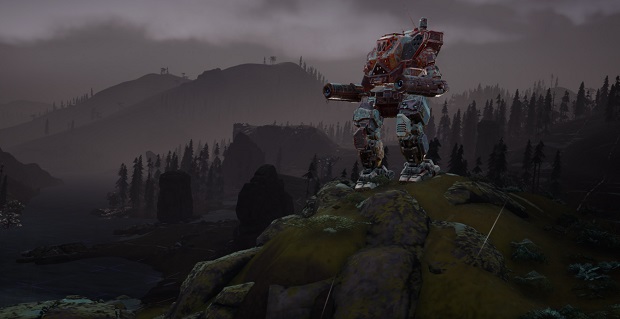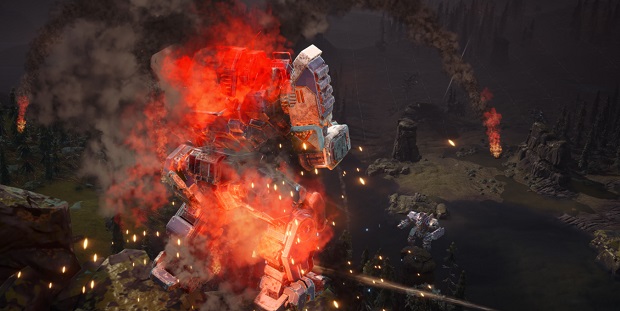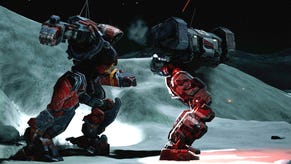BattleTech is the mech game I've always wanted
A farewell to arms
BattleTech [official site] finally brings mechs and mercs back to their turn-based tactical roots, and if the combat is backed by a worthy campaign mode, it's likely to be one of my favourite games of 2017. I've only played the skirmish mode, against AI opponents, so I can't assess the quality of the campaign. But the actual mech clashes are absolutely glorious, and as spectacular as any turn-based battles I've ever seen.
The moment BattleTech's creator, Jordan Weisman, told me I could punch a mech I knew that I'd be punching a lot of mechs. Melee combat can be useful from a tactical perspective, closing distance on mechs with dangerous ranged weapons, but I'll be honest; I just wanted to see robots beating the crap out of each other. In that respect, and several others, BattleTech overshot my expectations.
When I landed my first blow, on a mech already staggered and scorched by lasers and missiles, its arm flew clean off and rolled down a hill. Winding up for a second slug, I crossed all of my fingers hoping I'd be able to go full Black Knight and land another flesh wound.
BOOM
Off went the other arm. The mech swayed and for a brief moment, I thought it was going to topple, but it managed to stay upright, armless but not harmless. Its turn was next and rather than fleeing, it headbutted me.
Seeing an armless mech resort to a headbutt is very funny. BattleTech is a serious game about serious business, but this particular situation was pure farce.
A volley of missiles and heavy cannon fire from an ally finally toppled the poor mech and, having already punched its arms off, I felt it was only right to finish it off at close quarters. The killing blow was a stomp to the face, with a grinding of the heel into the junked remains for good measure.
Now, this is a turn-based tactical game, not a reboot of nineties beat 'em up duffer Rise of the Robots, so the bot-punching isn't all that important in the grand scheme of things. But it sort of is. The most surprising thing about BattleTech is how beautiful the damage models are, and how much weight there is to the combat and movement. Lasers scorch and singe the metal, missiles leave steaming gouges in armour, and flames encase overheating mechs, cooking the poor pilot.
They're super-weapons, yes, but they're also giant, heavy, precarious, vertical tanks. Formidable for sure, but when they clash against others of their kind they can suddenly seem terrifyingly vulnerable.
A lot of that comes down to the ways in which they can suffer. Mechs can be adversely affected in three ways. There's damage, the most direct way to destroy or dismember an opponent. When you fire on a target, you'll unleash every applicable weapon by default. There are more than thirty mech builds in the game and some are equipped to be effective at short, mid or long range, while others have a more measured spread of weaponry. The point is, you'll want to keep your distance with certain mechs, in order to ensure your best weapons are functional, while others will want to close in for the kill.
Before letting a salvo loose, you can switch off specific weapons. The main reason to toggle weapons off is to avoid overheating. Every armament creates a certain amount of heat when fired, and a certain amount to the target that it hits. A firebug mech devotes itself to dousing enemies in flames, forcing systems to shut down as they become too hot to operate, but even non-specialist machines can cook their enemies with laser fire and missile bursts. You're just as likely to overclock your own mechs as an opponents' though if you don't keep an eye on their heat. Firing a single weapon might tip them over the edge and cause them to malfunction temporarily.
The third and final trait to keep an eye on is stability. Take too much damage without bracing to steady and your mech might end up flat on its back. Once down, individual components can be targeted by opponents, meaning they can aim for the head to injure or kill the pilot, or take out weapons systems located on the arms and shoulders.
Shots can't be called and targeted at specific 'body' parts in general play, but the game models and tracks projectiles, and they will strike and cause damage to different areas. That brings the terrain into play; hide behind a ridge and your mech can be struck in its visible upper half but not in the legs. There are advantage to being up high as well, in terms of line of sight and accuracy, but you're also leaving mechs exposed by planting them on hillsides. Adding to this, one mech can act as a spotter for others, and any weapon that fires in an arc can be lobbed toward spotted enemies even if no direct line of sight exists.
There are other uses for terrain, such as letting a mech go for a paddle in a river to cool off, or stomping through woods for a small protective boost. Behind the scenes, BattleTech is undoubtedly rolling lots of digital dice to figure out the results of actions, but on the screen you see everything play out in beautiful detail, right down to the individual missiles in a volley, which might ping off a hill or dent a mech's chest armour.
In the skirmish mode, there's no need to conserve energy or protect mechs, which made charging in fists flailing seem like a fine option. There are two keys to the battlefield; managing your mechs heat and stability, and moving them into strong tactical positions. Flanking and attacks from the rear are vital for breaking through enemy armour without having to chip away in a face-to-face war of attrition, and knowing the strengths and weaknesses of your squad is vital.
And that's why I'm craving the campaign. There's a story, about a deposed ruler who is trying to regain power and Harebrained have shown their storytelling chops in the Shadowrun games. But that ruler doesn't take centre stage. She's important but she can also be ignored, because, Weisman tells me, the real star of the show is your mercenary company. You're free to take jobs from the various factions inhabiting and fighting over the various planets and systems that the sandbox-y campaign covers, and as you become better known and more well-trusted, you'll be able to take on bigger tasks for bigger paychecks.
Weisman says there's a fully functioning merc company management sim in the campaign, where you'll need to balance the books, hiring employees (including the Mechwarriors themselves, but also engineers and other techy sorts), promoting and levelling up those employees, and kitting out your mechs. That last part involves scavenging parts from fallen enemies as well as buying new bits from marketplaces, and that feeds back into the tactical battles; don't destroy the parts you might want to steal and stick on your own mechs.
It's the campaign that I really want to get my mitts on, but it wouldn't be worth a bean if the actual combat sections weren't worthwhile. They're more than that – the skirmish mode is fantastic, both as an exquisite visual depiction of the tabletop game that Weisman created decades ago, but as a game of tricksy tactics.
If sales are strong enough to support sequels or expansions, Weisman says he'd love to explore other eras of BattleTech, this game being intentionally set early in the history of the fictional future. From my perspective, if the campaign comes together, this will be the BattleTech game I've always wanted, so the idea it might eventually span several eras sounds fantastic.

